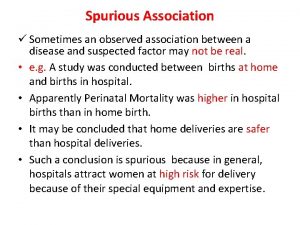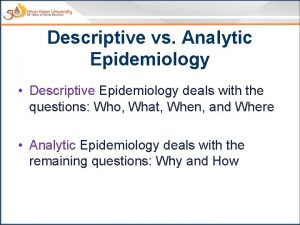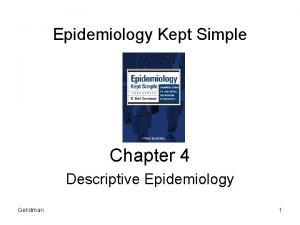Descriptive Studies Person Place and Time Descriptive Epidemiology
































- Slides: 32

Descriptive Studies: Person, Place and Time

Descriptive Epidemiology • Includes activities related to characterizing the distribution of diseases within a population Analytical Epidemiology • Concerns activities related to identifying possible causes for the occurrence of diseases

Descriptive Epidemiology • Epidemiological equivalent of the game “ 20 Questions” ü animal, mineral or vegetable? • In Descriptive Epidemiology: ü Who? - person ü Where? - place ü When? - time

Descriptive Epidemiology PLACE TIME PERSON Think of this as the standard dimensions used to track the occurrence of a disease.

Person • WHO is getting the disease? • Many variables are involved and studied, but factors such as sex, age & race often have a major effect.

Characteristics of Person • • Age Sex Ethnic group Socioeconomic status Nativity Religion Marital status Occupation

Age

Age

Sex

Time • WHEN does the disease occur? ü“Temporal” üRange from hours to decades • Type of disease dictates “time” element to be used • Graphic format often used ü y-axis (vertical) - frequency ü x-axis (horizontal) - time


Characteristics Relating to Time • • Secular change (long-term) Point epidemics (short-term) Cyclic trends Seasonal variation

Secular Change

Secular Change • Secular changes (“temporal variation”) occur slowly over long periods of time ü Longer than one year Incidence Rates of Cancers in Women Incidence Rates of Cancers in Men

Point Epidemics • Short-term changes occur over limited time frames ü Hours ü Days ü Weeks ü Months • Used for short-term exposures or diseases with short incubation and/or illness durations

Point Epidemics

Point Epidemics

Cyclic Trends • Cyclic trends may be either long-term or short term events. • Some are “seasonal” while others are cyclic due to other factors: ü Immigration ü School year ü Military deployment

Cyclic Trends

Seasonal Variation • Seasonal variation can be seen for some diseases or conditions falling within a calendar year

Seasonal Variation • Seasonal variation can be used to suggest possible etiology. Migratory Birds?

Time Clustering • Time clustering data can sometimes be used to trace the “beginning” to the introduction of a specific causal agent ü Thalidomide & birth defects First marketed in Europe in 1950’s as sleeping pill and to treat morning sickness in pregnant women ü Toxic Shock Syndrome Staphylococcus aureus infection in women using newly introduced hyperabsorbent tampons

Time Clustering

Place • WHERE are the rates higher? lower? • Geographic location of source • Geographic location of reservoir

John Snow and Cholera

5 Criteria of Place • Rate observed in all ethnic groups in the area • Rate NOT observed in persons of similar groups inhabiting other areas • Healthy persons entering area get ill at same frequency • People who leave do NOT show similar levels • Similar levels of infestation in other species (if zoonotic disease)

Characteristics Relating to Place • International • Variation within countries ü Urban-rural ü Local • Building Maps

Place Distribution of AIDS in the US 1990

Local

Building Maps

Interactions of Time and Place • Time-place clustering • Migration

 Person place time epidemiology
Person place time epidemiology First person second person third person
First person second person third person Difference between descriptive and analytical epidemiology
Difference between descriptive and analytical epidemiology Difference between descriptive and analytical epidemiology
Difference between descriptive and analytical epidemiology How to calculate incidence rate example
How to calculate incidence rate example Classification of epidemiological studies
Classification of epidemiological studies What is descriptive study in epidemiology
What is descriptive study in epidemiology Was ist 2. person plural
Was ist 2. person plural Person person = new person()
Person person = new person() First second and third person
First second and third person Paradigm shift from women studies to gender studies
Paradigm shift from women studies to gender studies Define nutritional epidemiology
Define nutritional epidemiology Certification board of infection control and epidemiology
Certification board of infection control and epidemiology Place place value and period
Place place value and period What is elapsed time
What is elapsed time Identifying prepositional phrases
Identifying prepositional phrases Mineral streak
Mineral streak Person-job fit and person-organization fit
Person-job fit and person-organization fit Person a and person b
Person a and person b Descriptive vs correlational vs experimental research
Descriptive vs correlational vs experimental research Perbedaan relative risk dan odds ratio
Perbedaan relative risk dan odds ratio Logistic regression epidemiology
Logistic regression epidemiology How to calculate prevalence
How to calculate prevalence Attack rate calculation
Attack rate calculation Bibliography of epidemiology
Bibliography of epidemiology Recall bias example
Recall bias example Attack rate calculation
Attack rate calculation Gate frame epidemiology
Gate frame epidemiology Biological plausibility
Biological plausibility فاطمة خليفة
فاطمة خليفة Defination of epidemiology
Defination of epidemiology Distribution in epidemiology
Distribution in epidemiology Spurious association in epidemiology
Spurious association in epidemiology























































